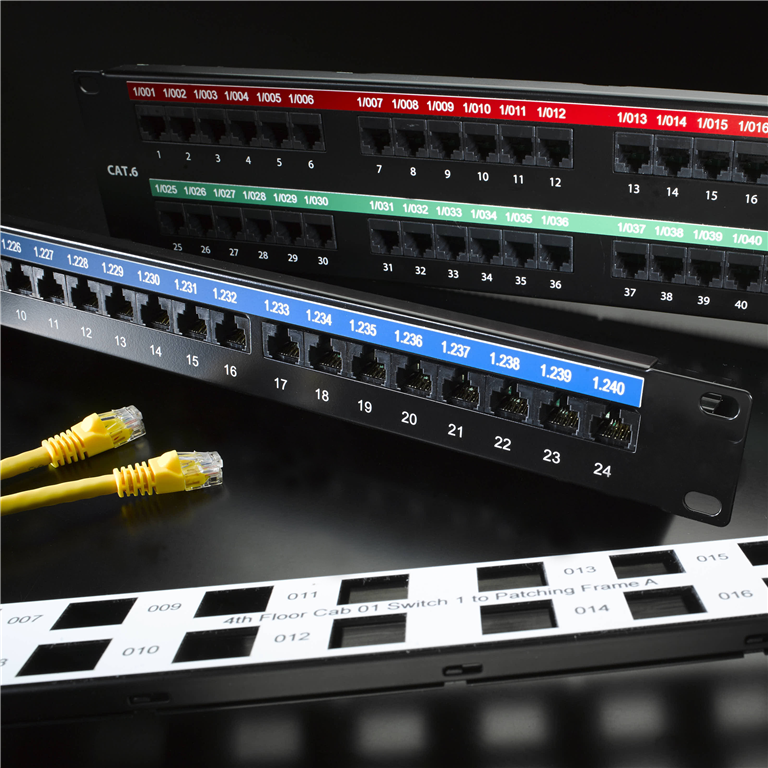Designation Labeling Sheets for 110 Wiring Blocks
Perforated label sheets are an easy way to label and ID and circuit any 110 wiring blocks. Label sheets is only available in white. Downloadable template is provide as these sheets are compatible with most laser and inkjet printers.
- Labels are color-coded per ANSI/TIA-606
- 8.5″×11″ US Letter sheets compatible with most general-purpose office printers
Patch panels, just send your numbers or excel sheet and we make to order. Label Templates. Engraved Patch Panel labels. Our Engraved 3D Printed labels are.
Download Template (DOC 111 Kb) Revised 07.14.2016
- Factory templates of termination panels that come pre-fitted with specific sockets include a pre-defined but modifiable configuration when you add the template to your project. Sockets previews are snows in the preview pane, when exporting a Wiring Schedule, as well as added when exporting to PDF, image or Excel, and of course when printing.
- Patch Panel Labeling Solutions. For an organized installation, use a labeling kit to quickly and easily identify ports on your patch panel. Universal/110-style labeling kits for 12-, 24-, 48-, and 96-port panels. QuickPort® kits available for 24-, 32-, and 48-port panels. Label holders include adhesive backing.
| Part Number | Description | Add to [?] |
| 110WB-LS4PR-WH | Label Sheet for 110 Wiring Blocks, 6 × 4 Pairs, 20 50-Pair Labels/Sheet, White |
In this post, I will be doing a brief commentary on creating and maintaining a physical port mapping spreadsheet. A port mapping spreadsheet is useful for keeping track of used/available ports on your network equipment, thoroughly documenting to which remote device each port connects, and generating configuration scripts to update port descriptions on the equipment.
You can download this article’s template file using the link to the right.
What to Document
The first question to ask when deciding to create a port mapping is which details should you record. The answer completely depends on your specific environment and what you plan to do with the documentation. Different requirements demand different data to be collected. I recommend you identify what you would like to do with this documentation before collecting and creating it. All that being said, the template linked to on this post contains a baseline of the most common data points which can provide a solid starting point.
Type
This field details the layer-1 and layer-2 media and protocols used on the wire. Layer-1 can be things like RJ45, OM2 (SC), OS1 (LC), etc. Layer-2 can be things like Ethernet, PPP, or God forbid, Frame Relay.
Source Device Hostname & Port
These fields record the hostname and port information of the source device. Whenever possible, I will use the port name as it is seen in the configuration terminal of the device.
***NOTE***
In case you are wondering the difference between the source device and the destination device, there really is no difference other than the fact that the focus of the document is always on the source device. In other words, the complete listing of ports for a device can be found in the section of the document where it is focused on as the source.
Patch Panel Fabric & Port
When there is infrastructure cabling used in-between the source and destination device: it is handy to note down which patch panel and port is used for the connection. The “Fabric” column can be replaced with “Panel Name” or anything else which specifies the infrastructure cabling extension set.
Ortronics Patch Panel Label Template
Destination Hostname & Port
This field defines the remote (non-focused) device and port where the connection terminates. When the port on the source device is empty and unused, these fields will be blank.

Destination Device Notes
These fields can be used for notations about the destination device including information about its role, purpose, and if the documented link is in an aggregated group (port-channel).
Scripting Columns
The scripting columns are used to generate configuration scripts using the information contained in the other columns. The scripting columns in the template are set up to generate port descriptions for Cisco based switches and will automatically detect when the different “Notes” fields are populated.
Documentation Tips
Patch Panel Spreadsheet Template
Make sure to visit the homepage for this series Network Documentation Series: Preamble and review the generic documentation tips listed there which apply to all network-related documents.